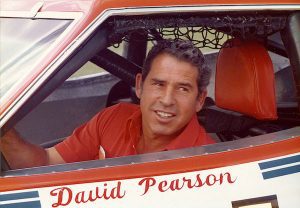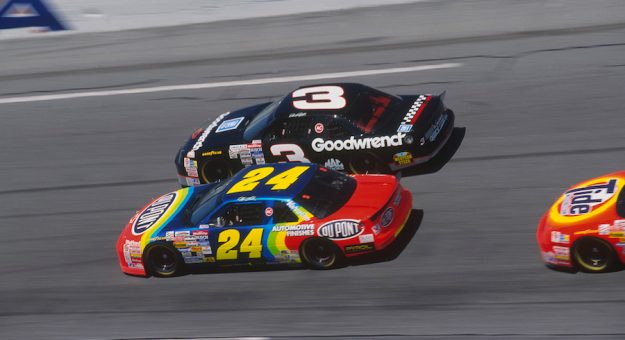Throughout 75 years of NASCAR racing, more than a few unusual — but true — stories have caught the attention of fans and racing historians.
The Petty Family Business
Located adjacent to the Petty family home in Level Cross, N.C., Petty Enterprises built and raced NASCAR Cup Series cars from 1949 through 2008.
The team’s patriarch, Lee Petty, was one of the first car owners to approach NASCAR racing as a business. As a driver, he won 54 races and earned three Cup Series championships. His eldest son, Richard Petty, won 200 races and seven titles, claiming the majority of his victories aboard Petty Enterprises’ famed No. 43 car.
Many fans may not realize that Richard Petty’s brother, legendary engine builder Maurice Petty, enjoyed a brief driving career. Maurice entered 26 Cup Series races. He made nine starts using No. 41, 11 starts using No. 42, four starts in the No. 43 car and two starts aboard the No. 44 machine.
Lee, Richard and Maurice Petty have all be inducted into the NASCAR Hall of Fame.
‘Park It In Alaska’
A humorous story involving Richard Petty occurred at Charlotte Motor Speedway on Oct. 9, 1983.
Petty earned his 198th Cup Series victory that day but there was a major problem in post-race inspection. Turns out the car had left-side tires on the right side, as well as an engine that measured 381.983 cubic inches, much greater than the limit of 358 cubic inches.

Team owner Rick Hendrick and crew chief Harry Hyde were sitting in a passenger car near victory lane as Petty went to talk with NASCAR officials after being told the car was illegal. Petty had made a verbal commitment to drive for Hendrick in 1984.
“Harry and I were sitting there waiting for Richard because it was taking a long time,” Hendrick said. “I remember Richard walking up to our car. Harry rolled the window down. Harry always called him Hank for some reason, and he said, ‘What’s going on, Hank?’
“Richard said, ‘My motor is checking a little big.’ Harry said, ‘Well, don’t worry. As soon as it cools down, it will be all right,’” Hendrick continued. “Richard dropped those sunglasses that he always wears and said, ‘You can park that thing in Alaska and it ain’t gonna check any smaller.’”
NASCAR officials allowed Petty to keep the win but fined him $35,000 and stripped him of 104 points. Petty added, “We have accepted NASCAR’s penalty. I just drive the car. I didn’t know anything about the motor or the tires.”
Petty went to Mike Curb Motorsports in 1984 and Hendrick hired Geoff Bodine.
Up The Creek
Junior Johnson, a 50-time Cup Series winner as a driver between 1953 and ’66, also owned championship race teams until 1995 with a who’s who of drivers wheeling his Chevrolets, Buicks and Fords.
During the 1984 and ’85 seasons, Johnson fielded Chevrolets for Darrell Waltrip and Neil Bonnett.
Johnson’s garages in Ingle Hollow, N.C., were separated by a creek with a small bridge at its center. Johnson often used their geographical locations to help keep his teams competitive during the days leading up to races.
“Junior would often walk into our shop and say, ‘Oh, you just wouldn’t believe what Bonnett’s boys are saying about you all over here,’” said former crew chief Jeff Hammond. “He’d get us all stirred up like a bunch of mad hornets and then he’d walk across that bridge and say, ‘Oh, you just wouldn’t believe what Waltrip’s boys are saying about all you guys,’ when he’d walk in over at Bonnett’s shop.
“He would do that to keep everyone fired up and a little on edge before the races ever started,” Hammond added. “No one would ever question Junior if it were true or not because it was Junior.”
The Number 17
Waltrip moved from Johnson’s team in 1987 to Hendrick Motorsports and remained there until forming his own team in 1991. The three-time series champion enjoyed nine victories with the Hendrick organization, including the 1989 Daytona 500.
There is an amazing backstory leading up to Waltrip’s only Daytona conquest.
“When Jeff Hammond and I sat down on Saturday before the race and started looking at the numbers, we were surprised,” Waltrip said. “I was driving car 17. The race purse was $1.7 million. We had pit number 17. We were in garage stall 17 and all this was random. It kept going on.
“It was my 17th Daytona 500. My name is Darrell Lee Waltrip and it has 17 letters. Our house was built on lot 17. My golf handicap was 17. It was 1989. Eight plus nine equals 17,” Waltrip continued. “Jeff said, ‘What do you think that means?’ And I said, ‘It means we’re either going to finish first or 17th. I’m just not sure which one.’”
Waltrip won and it was the 72nd of his 84 Cup Series victories.
Borrowing Dad’s Car
During the 1988 Diehard 500 at Talladega (Ala.) Superspeedway, Davey Allison served as a relief driver for Mike Alexander in the No. 12 Stavola Brothers Racing Buick.
Allison entered the car during the sixth caution period after Alexander exited on pit road due to heat exhaustion.
The significance of Alison driving the car was that his father, Bobby Allison, started the season in the car and drove it to victory in the Daytona 500 six months earlier. The elder Allison, however, had been injured in a crash at Pennsylvania’s Pocono Raceway, which ended his career.
It is believed to be the only time a son has driven a father’s car in Cup Series competition.
Eight Crash-Free Years
Driving the No. 3 Richard Childress Racing Chevrolet, Dale Earnhardt ran 208 consecutive Cup Series events without being involved in a race-ending crash.

The streak stretched from July 4, 1986, to Aug. 21, 1994, during which Earnhardt completed 83,658 laps.
Earnhardt crashed at Daytona Int’l Speedway in July 1986 after completing 151 of the race’s 160 laps. His next crash came eight years later during a two-car incident with Todd Bodine on lap 56 of the 200-lap event at Michigan Int’l Speedway.
“Todd and I came off the corner and we were close trying to draft,” Earnhardt told ESPN during the race broadcast.
“I passed back by him off the straightaway and we got together. When we got together, his car sort of pinched to the right. I tried to get away but I couldn’t. He spun to the outside and someone hit me in the rear and spun me to the inside. Then I came back up and spun up against the wall, He’s OK. We talked and hopefully everything is OK.”
Number Change
Jeff Gordon’s number with Hendrick Motorsports was to have been 46 instead of 24.
The change was made because of a licensing issue with the “Days of Thunder” movie that was released in 1990. One of the top cars in the movie carried No. 46 and the production company had secured the rights to produce and market merchandise with that number.
Gordon ended up using No. 24 for the majority of his career, except when he filled in for injured Dale Earnhardt Jr. in 2016 and drove Earnhardt’s No. 88 Chevrolet.
Hendrick Motorsports used the No. 46 in the 1993 Daytona 500 with defending Indianapolis 500 winner Al Unser Jr., who finished 36th in his only NASCAR start. That same year, HMS entered a Chevrolet that was to be driven by Buddy Baker in the July 25 race at Talladega Superspeedway but failed to qualify.
“We did a car for Buddy Baker because Buddy helped us a good bit on the speedway stuff when we first started and we had to run a car and we just slapped No. 46 on it,” said longtime Hendrick Motorsports crew chief Ray Evernham. “To my knowledge, it’s the only time that we ever had a No. 46 on the DuPont paint scheme (customarily ran by Gordon).”
Dashboard Lighter
Three-time Cup Series champion David Pearson drove for Wood Brothers Racing from April 16, 1972, through April 8, 1979. Pearson had one request upon joining the team — that a cigarette lighter installed in the car.
“I don’t think it was a big deal during that era, really,” said Eddie Wood, son of team co-founder Glen Wood and present co-owner of the team. “David would put a few cigarettes in his driver’s suit pocket before each race and have one sometimes when the cautions would come out.
“They had open-faced helmets, so it wasn’t a problem to do it,” Wood added. “Buddy Baker told a story once of how he looked over at Talladega while they were racing and saw him smoking during the race.”
The 1971 Mercury that Pearson drove in 1972 is in The Wood Brothers Museum — cigarette lighter and all.
